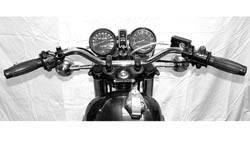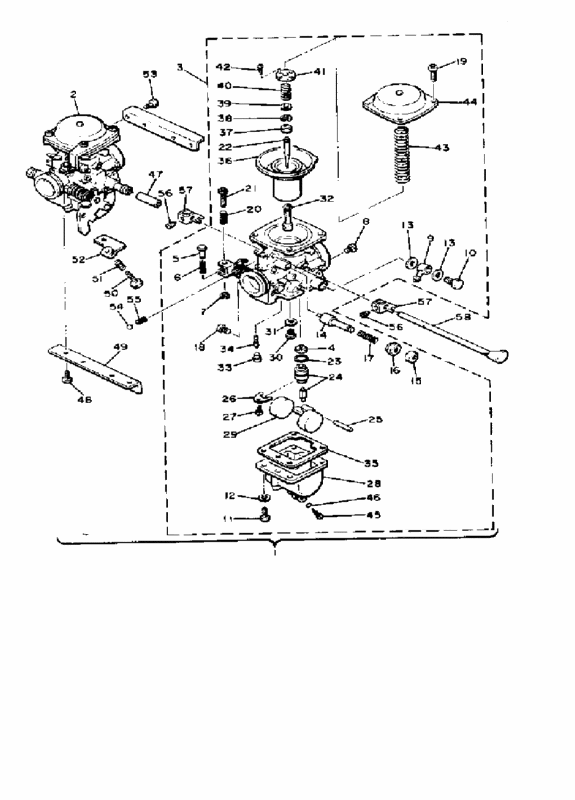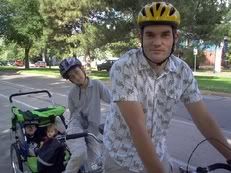Running woe #3: anemic idle requiring blipping throttle
I still had the annoying problem of the idle slowing down. When I'd close the throttle, the idle would immediately drop to about 1200 RPM, but as I sat at stoplights, the idle would get lower and lower until the bike stalled out after about 10 seconds, if I didn't continually blip the throttle. Turning up the idle adjuster screw, even just a quarter turn, would cause the engine to idle about about 3500 RPM.
I thought this idling behavior might be typical of small motorcycles. My sketchy old Seca idled in much the same way. However, when I took the ABATE Experienced Rider course on the provided little Honda Nighthawk 250s, I was stunned that they idled so well. Sitting on the little Nighthawks felt like sitting on a little happy sewing machine that would happily hum along all day at idle.
Then I rode my brother-in-law's 1968 Honda CB450 twin. It too idled like a little sewing machine. Also it's european-style handle bars made me more determined to get rid of my XS400's semi-ape-hanger-custom bars and replace them with something more sporting.
So, I set to work trying to figure out what was wrong with my bike that would force the idle to die a slow death if I didn't blip the throttle.
I thought maybe the issue was a weak spark at idle, which made the engine not run so well, which reduced the RPM, which weakened the spark, etc...causing the engine to eventually stall out. I checked the coils with a multimeter, and they were fine. I had read on The Used Motorcycle Guide about old Yamaha SR500s that would cut out in traffic until the owners replaced their resistance plug boots with non-resistance plug boots. So I ordered new plug wires, non-resistance boots, and a new euro-style handlebar from Mike's XS. The parts, prices, and service was great. The handlebars transformed the bike:

Unfortunately, the idling problem persisted.
So I thought that maybe the pilot jet circuit in the carbs was still clogged with crud, that I wasn't getting sufficient fuel to idle well, and that the only reason I was able to idle is that I had the idle turned up to the verge of the primary fuel circuit...that would certainly explain the touchiness of the idle adjuster screw. So, I tore the carbs apart again, pulled the pilot jets (Size 42.5 Type BS30/96). Although the brass looked a little corroded, none of the passages were blocked. The ends of the jets near the screw driver slots were a little chewed up, but nothing too bad...I think I'll order a new set in case I ever get around to tearing the carbs down again. I cleaned up the jets, reassembled everything, but alas, I still had the same anemic idle.
Then I had a revalation...CV carbs have a spring that pushes down a slide in the carb body (part # 43 in the diagram below).

If that spring was exerting too much pressure on the slide, then the slide would close like a butterfly whenever there wasn't a lot of vacuum above the diaphram. This would cause the idle to drop slowly as the slide was forced closed by the spring until the bike died. The sensitivity on the idle set screw could be caused because the idle was set so it was on the verge of moving the slides up, and setting it even a tiny bit higher would cause the bike to rev up to the butterfly setting (vs. the forced-closed slides' setting which was limiting the idle speed)
Luckily the bike came with a set of extra, gummed-up parts carburetors...
This weekend, I pulled the slide return springs from my bike, and they were about twice as long as the slide return springs from the parts carbs! I put the shorter springs into the working carbs on the bike, and it ran beautifully! I let it sit there idling happily for ten minutes! I revved it up, and it always quickly returned to its happy and consistent idle.
Unfortunately, I didn't have a chance to go for a ride to see how it really ran...but I have high hopes!
I thought this idling behavior might be typical of small motorcycles. My sketchy old Seca idled in much the same way. However, when I took the ABATE Experienced Rider course on the provided little Honda Nighthawk 250s, I was stunned that they idled so well. Sitting on the little Nighthawks felt like sitting on a little happy sewing machine that would happily hum along all day at idle.
Then I rode my brother-in-law's 1968 Honda CB450 twin. It too idled like a little sewing machine. Also it's european-style handle bars made me more determined to get rid of my XS400's semi-ape-hanger-custom bars and replace them with something more sporting.
So, I set to work trying to figure out what was wrong with my bike that would force the idle to die a slow death if I didn't blip the throttle.
I thought maybe the issue was a weak spark at idle, which made the engine not run so well, which reduced the RPM, which weakened the spark, etc...causing the engine to eventually stall out. I checked the coils with a multimeter, and they were fine. I had read on The Used Motorcycle Guide about old Yamaha SR500s that would cut out in traffic until the owners replaced their resistance plug boots with non-resistance plug boots. So I ordered new plug wires, non-resistance boots, and a new euro-style handlebar from Mike's XS. The parts, prices, and service was great. The handlebars transformed the bike:

Unfortunately, the idling problem persisted.
So I thought that maybe the pilot jet circuit in the carbs was still clogged with crud, that I wasn't getting sufficient fuel to idle well, and that the only reason I was able to idle is that I had the idle turned up to the verge of the primary fuel circuit...that would certainly explain the touchiness of the idle adjuster screw. So, I tore the carbs apart again, pulled the pilot jets (Size 42.5 Type BS30/96). Although the brass looked a little corroded, none of the passages were blocked. The ends of the jets near the screw driver slots were a little chewed up, but nothing too bad...I think I'll order a new set in case I ever get around to tearing the carbs down again. I cleaned up the jets, reassembled everything, but alas, I still had the same anemic idle.
Then I had a revalation...CV carbs have a spring that pushes down a slide in the carb body (part # 43 in the diagram below).

If that spring was exerting too much pressure on the slide, then the slide would close like a butterfly whenever there wasn't a lot of vacuum above the diaphram. This would cause the idle to drop slowly as the slide was forced closed by the spring until the bike died. The sensitivity on the idle set screw could be caused because the idle was set so it was on the verge of moving the slides up, and setting it even a tiny bit higher would cause the bike to rev up to the butterfly setting (vs. the forced-closed slides' setting which was limiting the idle speed)
Luckily the bike came with a set of extra, gummed-up parts carburetors...
This weekend, I pulled the slide return springs from my bike, and they were about twice as long as the slide return springs from the parts carbs! I put the shorter springs into the working carbs on the bike, and it ran beautifully! I let it sit there idling happily for ten minutes! I revved it up, and it always quickly returned to its happy and consistent idle.
Unfortunately, I didn't have a chance to go for a ride to see how it really ran...but I have high hopes!


11 Comments:
I also have an xs400. This sounds a little bit like a problem I am currently having. At least, I hope it doesn't - I am not sure if I am ready to get into the carbs. Although, I guess I have to sometime. (I did have them cleaned by a shop recently - jets, bowls, etc replaced).
Sometimes it will idle and then slowly die. Othertimes, it won't idle hardly at all. I have to leave the choke open. Idle adjustment screw on the bottom of the carbs doesn't seem to help much in maintaining any kind of idle, let alone one at 1200rpm.
Any suggestions?
Thanks,
-John
Hey John,
I'd suggest:
1. Check for vaccuum leaks
2. Clean out carbs and check the condition of the diaphrams, etc. inside (sounds like you've already had a shop do this)
3. Mess around with the idle mixture screws on top of the carbs...I didn't have much luck with this until I got a Colortune...which made it REALLY easy and is what *finally* allowed me to get it running right.
Good luck!
-Andy
hi,
i have a xs400 too,
how come the idle/mixture screw not shown on the diagram ? are you only using the adjusting knob ?
There is a mix screw. It's is on top in between the carbs and the engine
:S
does it mean tou have to take the carbs out (or the tank) to adjust Idle ??
No, there is a hole to access on top of the carbs.
check out this forum for a lot of good information.
http://www.yamahaclub.com/forums/index.php?showforum=33
ok but i mean you can't adjust the idle while the bike is running.
you can,t access this screw if the carbs are on the bike right ?
You can if you move the tank out of the way and have a long but thin flat head screwdriver.
I don't recall what the stock setting is. Just be careful when seating it in. They can break.
Hi Ricco,
> you can't adjust the idle while the bike is
> running. you can,t access this screw if the
> carbs are on the bike right ?
There are 3 points of adjustment:
1. The idle richness: this controls the air/fuel ratio at idle -- the screws are on top of the carbs. These are the screws John refers to...they're easier to get to if you loosen/remove the tank. My experience is that these are impossible to get right without a mixture analyzer (like a Colortune)
2. Individual carb's idle speed adjustments. These are on the throttle linkage and are accessed from the top. They control the balance between the carbs. To set up carb balance, get a 6-foot-long piece of clear tubing, mark the middle of it with permanent marker, and put a few CCs of gear oil in it. Drape the tubing over a handlebar and hook the ends of the tubing up to the barbs on the intake manifold and start the bike. Adjust the individual idle speed until the gear oil rests in the middle of the tube.
3. The idle stop adjustment. This controls the overall idle RPM. It is a knurled plastic knob that is accessible from below the carbs. While you're sitting on the bike, you can reach down under the carbs and turn it to change the idle. Be sure to have your riding gloves on if the engine is hot.
For adjustments 1 and 2, I've found it's easier to just remove the tank, set it somewhere next to/above the bike, and hook it up with a longer piece of line when playing with these.
Good Luck!
-Andy
Hi Andy,
thank you very much for the accuracy of your answer !
very helpful :)
i'm not sur I can adjust the throttle cables independently on my carbs but that's ok.
Could you gimme some advice about jetting too ?
i'm using KnN filter pods and i cut the stock pipe and mounted a bullet muffler with a baffle.
i incresed the main jet to 140 and downsized the air jet to 140 too.
the bike runs ok but struggle a lot at low rpm.
what do you think ?
thank you very much !
Hi Ricco,
Using a colortune is the most effective way to get everything right.
This article lays the process out in great detail.
You can get used colortunes on Ebay for about 50 bucks.
Good Luck!
-Andy
Post a Comment
<< Home